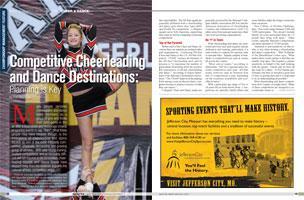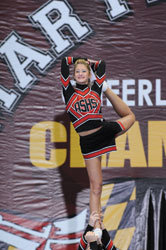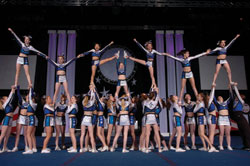
Many people perceive cheerleaders and dance team members as a group of girls who throw their pom-poms in the air after a touchdown and encourage crowds at sporting events to say, "Rah!" What these people may have missed, though, is the emergence of cheerleading and dance squads as one of the most intensely competitive, physically demanding and growing group of athletes. With year-round training, multiple competitions, and an incredibly difficult skill set required to be competitive, cheerleading squads and dance teams have stepped away from the sidelines and onto the national athletic competition stage.
 From its informal inception in 1898, cheerleading and dance has matured into an enormous industry that includes over 3.3 million participants separated into three divisions. School and Recreational squads have a team to cheer for and their primary focus is fulfilling this responsibility. The All-Star squads are generally affiliated with a cheerleading and dance gym where they learn skills specifically for competition. Collegiate squads serve both functions, supporting their team as well as competing in national competitions.
From its informal inception in 1898, cheerleading and dance has matured into an enormous industry that includes over 3.3 million participants separated into three divisions. School and Recreational squads have a team to cheer for and their primary focus is fulfilling this responsibility. The All-Star squads are generally affiliated with a cheerleading and dance gym where they learn skills specifically for competition. Collegiate squads serve both functions, supporting their team as well as competing in national competitions.
Top of the Pyramid
Within each of the Cheer and Dance divisions there are separate governing bodies and organizations. Overseeing All-Star Cheer and Dance is the U.S. All-Star Federation. USASF oversees all elements of the All-Star Cheerleading sport and its mission is "to maximize the number of participants benefiting from the positive life experiences of all star cheerleading and dance." According to Karen Halterman of the National Cheerleaders Association, "The USASF helps level the playing field among event producers/cheer companies because it assures everyone of what they can expect."
Collegiate Cheer and Dance teams are generally governed by the National Collegiate Athletic Association (NCAA) and the American Association of Cheerleading Coaches and Administrators (AACCA) while School/Recreational teams have their own local governing organizations.
No "I" in Team
Both cheerleading and dance are year-round activities and each requires intense dedication and training, particularly if a team wishes to compete for regional, state or national titles. Squads compete in hundreds of competitions per year at venues all across the country.
"Most school teams," according to Halterman, "will do a regional and a national competition each year. All-Star teams, however, may do between four and ten competitions a year, depending on the locations, availability and cost-effectiveness."
With a participant age range of five to eighteen years old, no team travels alone. Competitions are typically family affairs and some families make the longer events into mini-vacations.
Don Collins, of All-Star Challenge, says, "Our events range between 2,500 and 5,000 participants. This doesn't include family; for every participant there are 1.5 people they bring with them." Other events, typically National Competitions, can draw upwards of 15,000 people.
Attention to and sensitivity for this reality is key when hosting a cheerleading and dance competition. Matt Hollander of the Mass Mutual Center says, "What makes these events unique is that they are usually long days. This requires a greater sensitivity on behalf of the staff working with the guests. Guests may be here all day long for a three- or five-minute performance but they've invested a great deal of time in getting here and it is important to be as understanding as possible."
Most cheerleading and dance competitions don't require overnight travel. Many of these competitions are designed to accommodate teams in neighboring cities and states that will drive up to four hours to compete then make the return trip home. For these events, organizers make every effort to ensure that the competitions run on time. Shawn Smith, of Eastern Cheer and Dance Association says, "We pride ourselves on always being on time, even often ahead of schedule, which is important to us."
Hitting the Road
Large attendance numbers mean that host sites must be able to handle an influx of families who are there to compete but also need outside activities to fill time before and after performance times, particularly for overnight events.
Dimi Kosmakos, of the Coastal Alliance Corporation, notes the importance of choosing a site that will have wide appeal and offer multiple possibilities. "Battle at the Capitol is our most successful event. Teams are excited to come to the city because the history of the city is exciting and because of the sights, shops and restaurants that are available. Participants can let their school know they're doing an educational trip and the kids can get credit for it."
Most cheer and dance event organizers prefer to hold their events in cities that offer numerous outside family amenities, such as theme parks, museums or historic sites. Additionally, organizers look for venues that are in close proximity to affordable hotels, restaurants, and airports.
On the Mat
When it comes to site selection Hollander recommends first asking a lot of questions of the venue and the gyms. "Ask the audience what's important to them when going to a site and then ask the venue to address those issues. There is a lot of competition for these events so you want to make sure you're creating an environment that's going to encourage them to participate in the future."
Because the venue is generally the greatest expense for an organization, they must choose wisely when selecting a location. For cheerleading and dance event organizers, ample space is a must.
"Organizers need space for floors, practice areas and enough seating to seat spectators. The floor dimensions are generally 54 x 42, and a venue must be able to accommodate a floor of this size or larger" says Smith.
These venues also need to be able to alternate between two types of floors because dance competitions require a separate type of floor than cheerleading competitions and addressing this need is a must for organizers and venue staff.
 In addition to space requirements, event organizers must take into consideration whether other events are taking place at the site or in the city at the same time. Halterman says, "We don't necessarily want to be at a Convention Center with another large event. We want to make sure that our attendees have ample parking and if there is another event going on at the same time, it can cause problems with our attendees' event experience."
In addition to space requirements, event organizers must take into consideration whether other events are taking place at the site or in the city at the same time. Halterman says, "We don't necessarily want to be at a Convention Center with another large event. We want to make sure that our attendees have ample parking and if there is another event going on at the same time, it can cause problems with our attendees' event experience."
Paying close attention to other competitions or events that may be taking place or have recently taken place in a chosen city is vital to the success of any cheer or dance event. Kosmakos says, "We try not to use a facility that will not work with us on a 30-day non-compete clause. [Cheer/Dance Teams] don't want to go to the same facility two weeks in a row or even twice in a month."
In response to these concerns, Tara Green of the Dallas Convention & Visitors Bureau says, "I can understand the sensitivity of the issue and all CVBs take it very seriously and want to make sure all their groups feel important and get the service they deserve."
Gimme a C!
It's important to establish a strong relationship between the CVB and the sponsoring organization. Key to this relationship is communication and realistic expectations. Halterman of NCA and John Webb of the Ft. Lauderdale Convention Center agree that correct marketing of the event and being accurate and realistic about the number of expected attendees will help forge a lasting connection between the organization and the venue.
"Be as up front and realistic as possible, don't over exaggerate numbers," says Webb. Halterman adds, "Be straightforward with expectations. Be up front with what attendees are getting and the level at which they're competing."
Plan... Way Ahead.
Advanced planning is key to sponsoring a successful cheerleading and/or dance competition. Most cheer/dance organizations plan their events at least a year in advance, some further out. CVBs and other venues also plan well in advance. According to Green, "There is no substitute for planning as far out as possible, especially when booking an event in a convention center. The further out you can go the better opportunity you have to get what you want."
The most important issue for everyone involved is safety. Because both cheerleading and dance have high risk for injury, it is imperative that facilities and event organizers do everything to prevent accidents and be able to handle any injuries that may occur. Collins says, "When you're dealing with kids who are performing these stunts, it's not enough just having paramedics on site if someone gets hurt. It's also important to have directions to the nearest hospital."
Hollander adds that because of the possibility for injury during cheer and dance events his staff has to "gear up and prepare for that, which keeps us on our toes but allows for a different level of interaction."
Promotion
Media coverage and promotion of these events is a responsibility shared by both organizers and hosts. Webb says, "We do our part in attendance building – we will do a blast e-mail, letting people coming to the area know what kinds of things they can do while they're in Ft. Lauderdale."
In addition to sending an e-mail blast, Webb will also send a press release to the local media. In some cases he invites the media to the event, depending on whether the organization wants it or not. This mentality obviously works as Collins, producer of the King of the Jungle competition, says, "The biggest reason we chose Ft. Lauderdale was because of the great job that the CVB does of promoting their city and promoting what is coming to their city. Plus they keep in good contact with my staff."
Hollander adds, "We try to be proactive in sharing the presenters' event schedules with local businesses that wouldn't traditionally be busy in the downtown area on the weekend and work to get them to stay open to accommodate guests."
The staff at the Dallas CVB takes a similar approach. Green says, "If an organization has a press release to get out or a message to convey, we help with this. A new organization could rely heavily on the CVB to get the event in the paper, on the radio, online. This allows us to step up to the plate and help a new organization."
X Factors
There are several other factors to keep in mind when planning a cheerleading and/or dance competition. The cheer/dance season is predominantly November to April. However, certain places in the Northeastern U.S. don't compete until December. Additionally, cheer and dance events are traditionally held on Saturdays and Sundays, but many of the states in the Southeastern U.S. won't compete on Sundays.
"It's important to pay attention to and know the industry and what's going on because some states have different sets of values and there are other factors that may affect the success of the event," says Kosmakos.
Something else to consider, primarily in the Northeastern states, is the presence of Unions and the rules associated with them. Most event organizers have their own staff ,but there are some areas that may require Union employees are used to handle elements of the event. This can affect the overall budget and it can impact scheduling and timing.
At the end of any cheer and dance competition, organizers want those who attended to feel that, win or lose, the judging was fair and the scoring was accurate. Both the cheerleading and dance squads want to feel that they were treated separately and fairly. Collins points out, though, "At the end of any event we don't want people talking about who won; we want them talking about the great time they had. We want them to forget that it's just a competition and we want everyone to feel they were part of a great experience."
Cheerleading and Dance organizations
Amateur Athletic Union
American Association of Cheerleading Coaches and Advisors
U.S. All-Star Federation
International All-Star Federation
International Cheer Union
National Alliance for School Cheerleading
National Collegiate Athletic Association
National Council for Spirit Safety and Education
National Federation of State High School Associations

